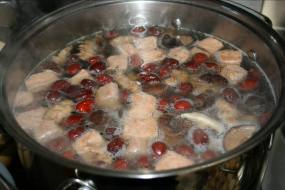 STIR FRY: If any technique in Chinese cooking demands proper preparation, it is stir-frying. Because the heat has to be high and there is little actual cooking time, it’s crucial to have all your ingredients assembled beforehand. Keep your stir fry ingredients separated in bowls based on how much time they need in your wok. Chop components to equal sizes so they have more uniform cooking time, and the result will be appealing and easy to eat. Stir fry comes in many categories such as: dry stir fry, cooking in gravy, pre cooked stir fry and raw stir fry.
STIR FRY: If any technique in Chinese cooking demands proper preparation, it is stir-frying. Because the heat has to be high and there is little actual cooking time, it’s crucial to have all your ingredients assembled beforehand. Keep your stir fry ingredients separated in bowls based on how much time they need in your wok. Chop components to equal sizes so they have more uniform cooking time, and the result will be appealing and easy to eat. Stir fry comes in many categories such as: dry stir fry, cooking in gravy, pre cooked stir fry and raw stir fry.
 DEEP FRYING: Deep-frying produces crisp textured food. Food that has been properly deep fried at the right temperature absorbs less oil and can be light and crispy without being greasy. When food is added to oil that has been heated to 380ºF, the surface of the food is quickly sealed, forming a coating the oil cannot permeate. If the oil is not hot enough, too much oil soaks in. You can test this by seeing if food sinks to the bottom of the oil; if so, the oil is not hot enough. If it’s too hot, the outside of the food can burn before the inside is cooked. You often see smoke rising from the oil.
DEEP FRYING: Deep-frying produces crisp textured food. Food that has been properly deep fried at the right temperature absorbs less oil and can be light and crispy without being greasy. When food is added to oil that has been heated to 380ºF, the surface of the food is quickly sealed, forming a coating the oil cannot permeate. If the oil is not hot enough, too much oil soaks in. You can test this by seeing if food sinks to the bottom of the oil; if so, the oil is not hot enough. If it’s too hot, the outside of the food can burn before the inside is cooked. You often see smoke rising from the oil.
 ROASTING: a cooking method that uses dry heat, such as an oven. Roasting usually causes carmelization of the surface of the food, which is considered a flavor enhancement. Most root and bulb vegetables can be roasted.
ROASTING: a cooking method that uses dry heat, such as an oven. Roasting usually causes carmelization of the surface of the food, which is considered a flavor enhancement. Most root and bulb vegetables can be roasted.
 STEAMING: Steaming is traditional Chinese cooking developed for when a moist dish was required as an alternative to a roasted one. To start, choose a heat resistant dish that’s slightly smaller than the steamer basket or wok so the steam can rise around it. Always bring the water to boil before adding food to the steamer. Occasionally check the water level as the food cooks. If it’s low, add boiling water to avoid lowering the temperature. Always open a steamer with care and lift the lid so that it points away from you.
STEAMING: Steaming is traditional Chinese cooking developed for when a moist dish was required as an alternative to a roasted one. To start, choose a heat resistant dish that’s slightly smaller than the steamer basket or wok so the steam can rise around it. Always bring the water to boil before adding food to the steamer. Occasionally check the water level as the food cooks. If it’s low, add boiling water to avoid lowering the temperature. Always open a steamer with care and lift the lid so that it points away from you.
 STEWING: is a time-honored moist cooking technique that allows the cook to assemble the dish and then let it simmer, with little or no attention, for an hour or more. Many “crock-pot” dishes are essentially stewed. In China, stews are usually cooked in a clay pot over a fire for hours at a time.
STEWING: is a time-honored moist cooking technique that allows the cook to assemble the dish and then let it simmer, with little or no attention, for an hour or more. Many “crock-pot” dishes are essentially stewed. In China, stews are usually cooked in a clay pot over a fire for hours at a time.
 RED COOKING and BRAISING: this is a slow cooking method in which food is first browned then gently simmered over low heat in a liquid consisting mainly of soy sauce and sugar. The food takes on a deep mahogany color glaze; a tender, juicy texture, and a rich full-bodied flavor.
RED COOKING and BRAISING: this is a slow cooking method in which food is first browned then gently simmered over low heat in a liquid consisting mainly of soy sauce and sugar. The food takes on a deep mahogany color glaze; a tender, juicy texture, and a rich full-bodied flavor.
 SIMMERING: simmering means gently cooking food just below the boiling point in enough liquid to cover it. This technique is used to make broths, soups, sauce, and stews.
SIMMERING: simmering means gently cooking food just below the boiling point in enough liquid to cover it. This technique is used to make broths, soups, sauce, and stews.
 BLANCHING or PARBOILING: refers to immersing foods in boiling water for a few seconds or a few minutes to partially precook it. .
BLANCHING or PARBOILING: refers to immersing foods in boiling water for a few seconds or a few minutes to partially precook it. .
